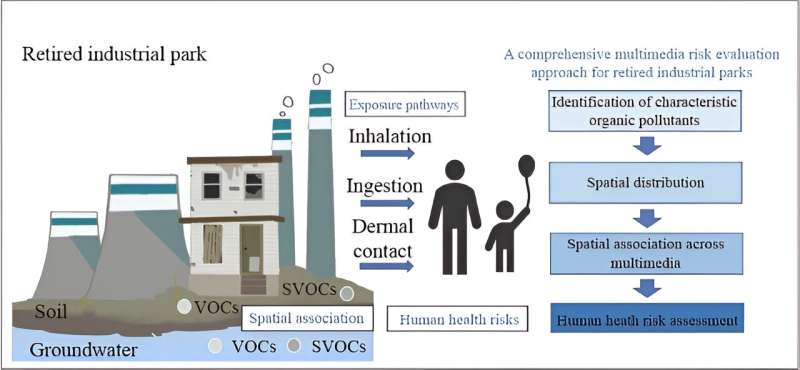This article has been reviewed according to Science X's editorial process and policies. Editors have highlighted the following attributes while ensuring the content's credibility:
fact-checked
proofread
Multimedia distribution and health risk assessment of typical organic pollutants in a retired industrial park

In developing countries, a large number of retired industrial parks require economical and effective risk assessment and remediation. Assessing the comprehensive risk of large retired industrial parks remains a considerable challenge due to the complexity of pollution sources and migration properties.
A team of researchers from Zhejiang University measured 11 semi-volatile organic compounds (SVOCs) and 27 volatile organic compounds (VOCs) in 531 soil and groundwater samples taken from a retired industrial park by coast in Zhejiang Province, China.
By taking a typical coastal industrial park in the Yangtze River Economic Zone as an example, this study provided a case basis for further exploring the migration of organic pollutants in shallow water layers and low soil permeability areas and the risk control of related industrial parks.
Their analysis was published in the journal Frontiers of Environmental Science & Engineering.
Due to economic reconstruction and urban expansion across from China, numerous industrial parks have been relocated, thus leaving behind numerous polluted retired parks, posing threats to human as well as the environment.
A nationwide soil survey in 2014 revealed that over 34% of soil samples from retired industrial sites in China exceeded the national soil quality standard. To address this issue, the Soil Pollution Prevention and Control Action Plan was launched, aiming to reset 95% of the contaminated sites for future use by 2030.
It's commonly recognized that redeveloping retired sites can bring extra benefits to society, the economy, and the environment. After urban layout optimization, it is predicted that more than 1,000,000 polluted areas can be redeveloped in China. However, the potential for human exposure to pollutants brought by the increasingly urgent demand for redeveloping polluted land has come out as a major environmental challenge.
Thus, accurate and efficient classification and grading of risk zones play an essential role in the process of redevelopment, enabling more effective risk management and targeted remediation efforts that ultimately protect human health and the environment.
During various industrial operations, abundantly used chemicals can be continuously emitted. Consequently, the soil and groundwater of retired industrial parks are often polluted with high concentrations of volatile organic compounds (VOCs) and semi-volatile organic compounds (SVOCs), posing persistent threats to human health.
Spatial complexity characteristics, source and sink mechanisms, and risk assessment of organic pollutants in retired industrial sites are focal issues in environmental research. Environmental distributions and health risks of heavy metals in soil and groundwater within industrial parks have been well-studied. Emphasis has been already placed on the management of possible risks generated by retired industrial parks, meanwhile ensuring consistency between economic and environmental benefits.
The migration and transformation of organic pollutants in environmental multimedia, especially in subsurface environments, are quite complex because of the hidden and highly discrete character of aquifers, the non-homogeneous properties of soil media, and the complexity of organic pollutant compositions. Therefore, it is important yet challenging to scientifically perform the cross-media evaluation of organic pollutants in decommissioned industrial parks.
Current understanding of the multimedia behaviors of organic pollutants is primarily based on laboratory simulations or model simulations. However, due to the complexity and variability of environmental and biological processes, these simulations may not accurately reflect actual conditions at contaminated sites.
To carry out effective remediation within limited time and resource conditions, initially it is essential to obtain the accurate depiction of pollution in retired industrial sites and the spatial distribution of pollutants, and secondly to prioritize the identification of critical areas with high health risks as well as an overall risk assessment of critical pollution across multimedia in large-scale retired industrial parks.
Spatial interpolation methods, such as inverse distance weighting (IDW) and Kriging, are used to analyze the spatial distribution patterns of organic pollutants. However, a comprehensive investigation of the spatial association of organic pollutants between two environmental media is still yet to be investigated.
The work of Professor Lizhong Zhu's team fills this gap. To figure out the gap, the Geodetector model is used to recognize potential causality between variables and quantify the spatial interaction between two environmental media, improving the precision of source identification and further risk assessment for organic pollutants.
The primary purpose of this work was to assess the risk of a large-scale retired industrial park thoroughly and further provide a basis for accurate and efficient classification and grading of risk zones. To help reach the overarching aim, the following specific goals were set by the team of Professor Lizhong Zhu:
- Identifying the characteristic organic pollutants and depicting their spatial distributions in soil and groundwater.
- Establishing the spatial association of characteristic organic pollutants across multimedia with the Geodetector model.
- Assessing the carcinogenic and non-carcinogenic risks of organic pollutants via exposure ways and determining the remediation goal based on future land use patterns.
The systematic and comprehensive multi-media risk evaluation approach for retired industrial parks proposed in this study provides an applicable tool for risk classification, grading, and zoning of retired industrial parks.
The study of organic pollution in multi-media in this study revealed the distribution and migration characteristics of organic pollution, which can be valuable for the fine portrayal of organic pollution in industrial parks.
More information: Shijin Wu et al, Multimedia distribution and health risk assessment of typical organic pollutants in a retired industrial park, Frontiers of Environmental Science & Engineering (2023). DOI: 10.1007/s11783-023-1742-9
Provided by Frontiers Journals





















